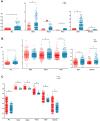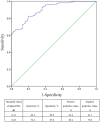Alpha-power in electroencephalography as good outcome predictor for out-of-hospital cardiac arrest survivors
- PMID: 35764807
- PMCID: PMC9240023
- DOI: 10.1038/s41598-022-15144-3
Alpha-power in electroencephalography as good outcome predictor for out-of-hospital cardiac arrest survivors
Abstract
This study aimed to investigate the utility of quantitative EEG biomarkers for predicting good neurologic outcomes in OHCA survivors treated with targeted temperature management (TTM) using power spectral density (PSD), event-related spectral perturbation (ERSP), and spectral entropy (SE). This observational registry-based study was conducted at a tertiary care hospital in Korea using data of adult nontraumatic comatose OHCA survivors who underwent standard EEG and treated with TTM between 2010 and 2018. Good neurological outcome at 1 month (Cerebral Performance Category scores 1 and 2) was the primary outcome. The linear mixed model analysis was performed for PSD, ESRP, and SE values of all and each frequency band. Thirteen of the 54 comatose OHCA survivors with TTM and EEG were excluded due to poor EEG quality or periodic/rhythmic pattern, and EEG data of 41 patients were used for analysis. The median time to EEG was 21 h, and the rate of the good neurologic outcome at 1 month was 52.5%. The good neurologic outcome group was significantly younger and showed higher PSD and ERSP and lower SE features for each frequency than the poor outcome group. After age adjustment, only the alpha-PSD was significantly higher in the good neurologic outcome group (1.13 ± 1.11 vs. 0.09 ± 0.09, p = 0.031) and had best performance with 0.903 of the area under the curve for predicting good neurologic outcome. Alpha-PSD best predicts good neurologic outcome in OHCA survivors and is an early biomarker for prognostication. Larger studies are needed to conclusively confirm these findings.
© 2022. The Author(s).
Conflict of interest statement
The authors declare no competing interests.
Figures



Similar articles
-
Background frequency can enhance the prognostication power of EEG patterns categories in comatose cardiac arrest survivors: a prospective, multicenter, observational cohort study.Crit Care. 2021 Nov 17;25(1):398. doi: 10.1186/s13054-021-03823-y. Crit Care. 2021. PMID: 34789304 Free PMC article.
-
Background Frequency Patterns in Standard Electroencephalography as an Early Prognostic Tool in Out-of-Hospital Cardiac Arrest Survivors Treated with Targeted Temperature Management.J Clin Med. 2020 Apr 13;9(4):1113. doi: 10.3390/jcm9041113. J Clin Med. 2020. PMID: 32295020 Free PMC article.
-
Echocardiographic parameters during prolonged targeted temperature Management in out-of-hospital Cardiac Arrest Survivors to predict neurological outcome - a post-hoc analysis of the TTH48 trial.Scand J Trauma Resusc Emerg Med. 2021 Feb 19;29(1):37. doi: 10.1186/s13049-021-00849-7. Scand J Trauma Resusc Emerg Med. 2021. PMID: 33608045 Free PMC article. Clinical Trial.
-
The Association Between Induction Rate and Neurologic Outcome in Patients Undergoing Targeted Temperature Management at 33°C.Ther Hypothermia Temp Manag. 2023 Mar;13(1):16-22. doi: 10.1089/ther.2022.0008. Epub 2022 Jun 16. Ther Hypothermia Temp Manag. 2023. PMID: 35708619
-
Neurological Prognostication After Cardiac Arrest in the Era of Target Temperature Management.Curr Neurol Neurosci Rep. 2019 Feb 9;19(2):10. doi: 10.1007/s11910-019-0922-2. Curr Neurol Neurosci Rep. 2019. PMID: 30739213 Review.
Cited by
-
Tailoring Targeted Temperature Management in Comatose Out-of-Hospital Cardiac Arrest Survivors: A Retrospective Analysis Based on the rCAST Score Classification.J Clin Med. 2025 Jun 3;14(11):3931. doi: 10.3390/jcm14113931. J Clin Med. 2025. PMID: 40507693 Free PMC article.
-
Normal value of neuron-specific enolase for predicting good neurological outcomes in comatose out-of-hospital cardiac arrest survivors.PLoS One. 2024 Jun 25;19(6):e0305771. doi: 10.1371/journal.pone.0305771. eCollection 2024. PLoS One. 2024. PMID: 38917136 Free PMC article.
-
Explainable machine learning model based on EEG, ECG, and clinical features for predicting neurological outcomes in cardiac arrest patient.Sci Rep. 2025 Apr 3;15(1):11498. doi: 10.1038/s41598-025-93579-0. Sci Rep. 2025. PMID: 40181037 Free PMC article.
-
Anti-shivering Drug Influences the Characteristics of Electroencephalographic Shivering Noise During Targeted Temperature Management: A Case Report.Cureus. 2025 May 20;17(5):e84509. doi: 10.7759/cureus.84509. eCollection 2025 May. Cureus. 2025. PMID: 40546650 Free PMC article.
-
Electroencephalographic and clinical predictors of favorable neurologic outcomes in pediatric cardiac arrest survivors.Sci Rep. 2025 Aug 27;15(1):31606. doi: 10.1038/s41598-025-15152-z. Sci Rep. 2025. PMID: 40866428 Free PMC article.
References
-
- Atwood C, Eisenberg MS, Herlitz J, Rea TD. Incidence of EMS-treated out-of-hospital cardiac arrest in Europe. Resuscitation. 2005;67:75–80. - PubMed
-
- Mozaffarian D, et al. Heart disease and stroke statistics–2015 update: A report from the American Heart Association. Circulation. 2015;131:e29–322. - PubMed
-
- Dragancea I, Rundgren M, Englund E, Friberg H, Cronberg T. The influence of induced hypothermia and delayed prognostication on the mode of death after cardiac arrest. Resuscitation. 2013;84:337–342. - PubMed
-
- Lemiale V, et al. Intensive care unit mortality after cardiac arrest: The relative contribution of shock and brain injury in a large cohort. Intensive Care Med. 2013;39:1972–1980. - PubMed
-
- Ben-Hamouda N, Taccone FS, Rossetti AO, Oddo M. Contemporary approach to neurologic prognostication of coma after cardiac arrest. Chest. 2014;146:1375–1386. - PubMed
Publication types
MeSH terms
LinkOut - more resources
Full Text Sources

